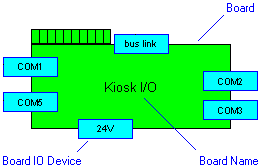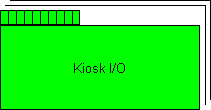



 on the Board's icon indicates that the item is a stub. For more information, see
Stubs.
on the Board's icon indicates that the item is a stub. For more information, see
Stubs. .
.If you select the Proprietary\Boards folder in the Dictionary pane, the Contents pane displays the following information about each Attribute in the model: Base Address. |
The Board Type list on the Options tab of a Board's Property Pages allows you to link the Board with a Board Type. |
 Dependency - The Dependency is owned jointly by the Board and the other associated item. The access permissions you have to a Dependency are determined by the access permissions of the dependent item.
Dependency - The Dependency is owned jointly by the Board and the other associated item. The access permissions you have to a Dependency are determined by the access permissions of the dependent item. Drop - The Drop is owned jointly by the Board and the associated Multidrop Bus. The access permissions you have to a Drop are determined by the access permissions you have to the source item.
Drop - The Drop is owned jointly by the Board and the associated Multidrop Bus. The access permissions you have to a Drop are determined by the access permissions you have to the source item. Point-to-point Connection - The Point-to-point Connection is owned jointly by the Board and the associated item. The access permissions you have to a Point to Point Connection are determined by the access permissions you have to the source item. Note that the Board does not own the Point-to-point Connections that are linked to the Board's Board IO Device.
Point-to-point Connection - The Point-to-point Connection is owned jointly by the Board and the associated item. The access permissions you have to a Point to Point Connection are determined by the access permissions you have to the source item. Note that the Board does not own the Point-to-point Connections that are linked to the Board's Board IO Device. Board Type - The linked Board Type specifies the Board IO Device, Processor and Memory requirements for the board.
Board Type - The linked Board Type specifies the Board IO Device, Processor and Memory requirements for the board. Package - The Package's software resides on the Board. Note that in the opposite direction this link means that the Package owns the Board. For more information, see
Linking a package with a board.
Package - The Package's software resides on the Board. Note that in the opposite direction this link means that the Package owns the Board. For more information, see
Linking a package with a board. Subsystem - Note that a Board cannot be linked to both a Package and a Subsystem.
Subsystem - Note that a Board cannot be linked to both a Package and a Subsystem.Like most other items in a Model, a Board can be linked to an
Activity Partition,
Comment,
Frame Box,
General Node,
General Flow,
General Flow Diagram Node,
Constraint (applied),
General Flow Diagram Flow or
Swimlane. |